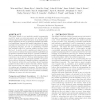Free Online Productivity Tools
i2Speak
i2Symbol
i2OCR
iTex2Img
iWeb2Print
iWeb2Shot
i2Type
iPdf2Split
iPdf2Merge
i2Bopomofo
i2Arabic
i2Style
i2Image
i2PDF
iLatex2Rtf
Sci2ools
DAC
2007
ACM
2007
ACM
Implicitly Parallel Programming Models for Thousand-Core Microprocessors
This paper argues for an implicitly parallel programming model for many-core microprocessors, and provides initial technical approaches towards this goal. In an implicitly parallel programming model, programmers maximize algorithmlevel parallelism, express their parallel algorithms by asserting high-level properties on top of a traditional sequential programming language, and rely on parallelizing compilers and hardware support to perform parallel execution under the hood. In such a model, compilers and related tools require much more advanced program analysis capabilities and programmer assertions than what are currently available so that a comprehensive understanding of the input program's concurrency can be derived. Such an understanding is then used to drive automatic or interactive parallel code generation tools for a diverse set of parallel hardware organizations. The chip-level architecture and hardware should maintain parallel execution state in such a way that a strictly...
DAC 2007 | Design Automation | Parallel Execution State | Parallel Programming Model | Parallel Programming Models |
| Added | 12 Nov 2009 |
| Updated | 12 Nov 2009 |
| Type | Conference |
| Year | 2007 |
| Where | DAC |
| Authors | Wen-mei W. Hwu, Shane Ryoo, Sain-Zee Ueng, John H. Kelm, Isaac Gelado, Sam S. Stone, Robert E. Kidd, Sara S. Baghsorkhi, Aqeel Mahesri, Stephanie C. Tsao, Nacho Navarro, Steven S. Lumetta, Matthew I. Frank, Sanjay J. Patel |
Comments (0)

